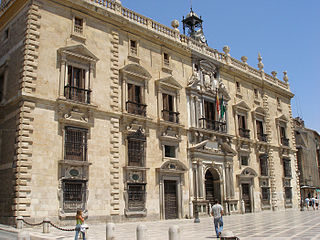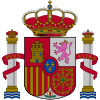
The Courts of Denmark is the ordinary court system of the Kingdom of Denmark. The Courts of Denmark as an organizational entity was created with the Police and Judiciary Reform Act taking effect 1 January 2007 which also significantly reformed the court system e.g. by removing original jurisdiction from the High Courts and by introducing a new jury system.

The Supreme Court (Filipino: Kataas-taasang Hukuman; colloquially referred to as the Korte Suprema, is the highest court in the Philippines. The Supreme Court was established by the Second Philippine Commission on June 11, 1901 through the enactment of its Act No. 136, an Act which abolished the Real Audiencia de Manila, the predecessor of the Supreme Court.

The Audiencia Nacional is a high court in Spain with jurisdiction over all of the Spanish territory. It is specialised in a certain scope of delinquency, having original jurisdiction over major crimes such as those committed against the Crown and its members, terrorism, forgery of currency, credit and debit cards and checks, some trade crimes committed in more than one region and over drug trafficking, food frauds and medical frauds committed in a nationwide level as well as over international crimes which come under the competence of Spanish courts.. It has also appellate jurisdiction over the cases of the Criminal Chamber of the National Court.

The General Council of the Judiciary is the national council of the judiciary of Spain. It is the constitutional body that governs all the Judiciary of Spain, such as courts, and judges, as it is established by the Spanish Constitution of 1978, article 122 and developed by the Organic Law 6/1985 of the Judicial Power (LOPJ). The President of the CGJP is also the president of the Supreme Court.

The judiciary of Pakistan is the national system of courts that maintains the law and order in the Islamic Republic of Pakistan. Pakistan uses a common law system, which was introduced during the colonial era, influenced by local medieval judicial systems based on religious and cultural practices. The Constitution of Pakistan lays down the fundamentals and working of the Pakistani judiciary.

The judiciary of Portugal is a system of courts that together constitute one of the four organs of Sovereignty as defined by the Portuguese Constitution. The courts are independent from the other three Portuguese organs of Sovereignty.

The Supreme Court is the highest court in the Kingdom of Spain. The court has original jurisdiction over cases against high-ranking officials of the Kingdom and over cases regarding the legalization of political parties. It also has ultimate appellate jurisdiction over all cases. The Court has the power of judicial review, except for the judicial revision on constitutional matters, reserved to the Constitutional Court.

The judiciary of Colombia is a branch of the State of Colombia that interprets and applies the laws of Colombia, to ensure equal justice under law, and to provide a mechanism for dispute resolution. The judiciary comprises a hierarchical system of courts presided over by judges, magistrates and other adjudicators.

The Judiciary of Spain consists of Courts and Tribunals, composed of judges and magistrates (Justices), who have the power to administer justice in the name of the King of Spain.

The High Court of Justice of Andalusia, Ceuta and Melilla, is the highest court of Andalusia, and for the Spanish autonomous cities of Ceuta and Melilla. Its seat is the former Royal Chancery of Granada. The TSJA has full power over all the jurisdictional orders: civil and penal law, social law, administrative disputes, and any other orders that may be created in the future.
The Judiciary of Sri Lanka are the civil and criminal courts responsible for the administration of justice in Sri Lanka. The Constitution of Sri Lanka defines courts as independent institutions within the traditional framework of checks and balances. They apply Sri Lankan Law which is an amalgam of English common law, Roman-Dutch civil law and Customary Law; and are established under the Judicature Act No 02 of 1978 of the Parliament of Sri Lanka.

The Judiciary of Burundi is the branch of the Government of the Republic of Burundi which interprets and applies the laws of Burundi to ensure impartial justice under law and to provide a mechanism for dispute resolution. The independence of the judiciary is guaranteed by the constitution.

The High Court of Justice of Castile and León, is the superior and appellate court of the Judiciary of Spain in the territory of the autonomous community of Castile and León, notwithstanding its original jurisdiction in some cases, and the jurisdiction of the Supreme court. Located in Burgos, the court is divided into the Civil, Criminal, Administrative and Labour (Social) chambers. The High Court is also tasked with the resolution of jurisdictional conflicts between the courts in Castile and León.

The superior courts of justice, or high courts of justice, are courts within the judicial system of Spain, whose territorial scope covers an autonomous community, as laid down in the Organic Law of Judicial Power.
The Judiciary of Albania interprets and applies the law of Albania. Albania's judicial system is a civil law system divided between courts with regular civil and criminal jurisdiction and administrative courts. Albanian law is codified and based on the French law. It is governed by the High Council of Justice (Këshilli i Lartë i Drejtësisë), and its management is aided by the office of the President of Albania, the Ministry of Justice, and the various courts chairpersons.

The Supreme Court of the Dominican Republic is the highest court existing in the Republic and is, therefore, the head of the judiciary in the country.

The High Court of Justice of Catalonia is the highest body and last judicial instance of the Spanish judiciary in Catalonia. Unlike the Parliament of Catalonia or the Executive Council of Catalonia, the TSJC is not a part of the Generalitat of Catalonia, the autonomous system of self-government of the community, although the Catalan government has some powers over it, especially in material resources.
The President of the Supreme Court and also President of the General Council of the Judiciary is the highest judicial authority of the Kingdom of Spain and holds the representation of the judicial branch and its governing body, the CGPJ. The office of President of the Supreme Court is foreseen in the Constitution as well as giving to the president the presidency of the General Council of the Judiciary. As a parliamentary monarchy, the President of the Supreme Court is appointed by the Monarch after being nominated by the Plenary of the General Council of the Judiciary, who serves until the end of its 5-years-term, its dismissal by the CGPJ or its resignation.
The Judiciary of Mexico officially the Judicial Power of the Federation is one of the three branches of government in Mexico, and the sole federal judiciary power. It is composed of the Supreme Court of Justice of the Nation, which serves as its highest court, the Federal Judiciary Council, the Federal Electoral Tribunal, regional courts, circuit and appellate collegiate courts, and district courts.
The High Court of Justice of the Canary Islands is the highest organ of the judicial power in the autonomous community of Canary Islands (Spain). It has its seat in Las Palmas de Gran Canaria.
















